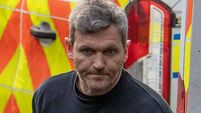Thousands mark 70 years since D-Day invasion

World leaders and dignitaries, including President Barack Obama and Queen Elizabeth will gather to honour the more than 150,000 American, British, Canadian and other Allied D-Day veterans who risked and gave their lives to defeat Adolf Hitler’s Third Reich.
For many visitors, the Normandy American Cemetery and Memorial with its 9,387 white marble tombstones on a bluff overlooking the site of the battle’s bloodiest fighting at Omaha Beach is the emotional centrepiece of pilgrimages to honour the tens of thousands of men killed on D-Day and the months of fighting afterward.
D-Day veteran Clair Martin, 93, said he’s come back to Omaha Beach three times in the last 70 years — “four if you count the time they were shooting at me”.
The San Diego, California resident landed on D-Day with the 29th Infantry Division and said he kept fighting until he reached the Elbe River in Germany the following April. “I praise God I made it and that we’ve never had another World War,” he said.
Ceremonies large and small were taking place across Normandy ahead of an international summit today in Ouistreham, a small port that was the site of a strategic battle on D-Day. French President Francois Hollande’s decision to invite Russian President Vladimir Putin to participate in the official ceremony despite his exclusion from the G-7 summit in Brussels is being seen by some as justified recognition of the Soviet Union’s great sacrifice in defeating Hitler, but by others as a distraction given the dispute over Ukraine.
With many D-Day veterans now in their 90s, this year’s anniversary has the added poignancy of being the last time many of those who took part in the battle will be able to make the long journey back to Normandy and tell their stories.
“Three minutes after landing, a mortar blew up next to me and I lost my K-rations,” said Curtis Outen, 92, of Pageland, South Carolina. Outen, making his first return to Normandy since the war, related the loss of his military-issued meal packet as though it happened yesterday. “Then I cut my arm in the barbed wire entanglements. After that I was all right.”
Hundreds of visitors walked among the cemetery’s long rows of white crosses and stars of David. Schoolchildren and retirees, soldiers in uniform and veterans in wheelchairs quietly move from grave to grave, pausing to read the brief inscriptions that can only give hints of the lives laid to rest there. Some 18 heads of state will attend today.
Putin, Obama and — thanks to a last-minute invitation from France — Ukraine’s president-elect Petro Poroshenko, will be among the leaders gathering for a closed-door lunch today.
“Yes, this is a day about the veterans and remembering those that died for basic freedoms, but it’s also an opportunity to look ahead and de-escalate the Ukraine crisis,” said one French diplomatic source.
No separate meeting between Putin and Obama is planned as yet but organisers at the Elysee palace say the luxurious halls of the 18th century Chateau de Benouville, where lunch will be prepared by four Michelin- star chefs, are being set up for bilateral meetings.
Speaking to French radio station Europe 1 on Wednesday, Putin offered to meet Obama in France.
“There is no reason to think President Obama does not want to talk to the Russian President,” he said. “It’s his choice. I am ready for dialogue.”
THERE were strong connections between this country and the D-Day invasion of Normandy that are often overlooked.
The epic film, The Longest Day, was based on the book of the same name written by Cornelius Ryan (1920-1974), who was born in Dublin and educated at Synge Street CBS, before becoming a war correspondent.
The amphibious invasion of Normandy required certain tides, relatively clear skies, and a full moon if possible. The optimum time in June 1944 was from the 5th to the 7th. Initially it was decided to launch the invasion on Monday, June 5, but a weather report from Ireland on the eve of the planned invasion set alarm bells ringing.
Since the start of the war, the Irish had been sharing their weather reports with the British in Dunstable, England. It was just one of the many ways in which this country helped the Allies. No such help was ever given to the Germans.
In February 1942 there were fears that the German legation had sent radio messages to Berlin with weather information that assisted three German battleships in their famous dash through the English Channel. Having promised more than 20 years earlier that an independent Ireland would never allow its territory to be used for an attack on Britain, de Valera insisted the German Legation should not use its radio transmitter again. Even though the transmitter was not used for more than a year, he went on to insist that it be deposited in the vault of a Dublin bank in December 1943 in order to ensure that it could not be used again.
Weather information from Ireland was particularly valuable when the weather was coming from the west. Britain could expect the same weather the following day.
On Sunday, June 4, Ted Sweeney, the assistant keeper of the lighthouse at Blacksod Point, Co Mayo, reported that a cold front had crossed the Irish coast and barometric pressure was falling rapidly. He recorded a wind speed of force 6. The invasion plan called for winds of no higher than force 4.
Dunstable asked Sweeney the check and repeat his report. “I just wondered what was wrong,” he later explained. “I thought I had made some error.
“They sent a second message to me about an hour after to please check and repeat again. I thought this was a bit strange so I checked and repeated again.”
Group Captain James M Stagg, the meteorologist appointed to advise the Supreme Allied Headquarters, advised that the landing be postponed on the strength of the report from Mayo. On June 5 there were force 7 winds and heavy rain in the Normandy area, which could have been catastrophic if the invasion had gone ahead as planned. When Sweeney reported rising pressure that day, the invasion was rescheduled for June 6.
It was estimated that some 66,000 Irishmen took part in the Normandy landings. During their seemingly interminable wait on the invasion ships, some relieved their tension in different ways.
Cornelius Ryan reported that James Percival “Paddy” de Lacy became quite emotional on hearing the Rose of Tralee played on bagpipes. “He forgot where he was and stood up and offered a toast to Ireland’s Éamon de Valera for ‘keeping us out of the war,’” Ryan noted.
SEÁN Deegan, from Ushers Island in the heart of Dublin, had joined the British Army in search of adventure. He had tried to join the Irish Army, but was told he was too young and too skinny, so he crossed the border and joined the Royal Air Force as a 17-year-old. He was not moved by any altruistic motives; he went strictly in search of adventure.
He was given Harley-Davidson motorbike to do reconnaissance work. As a 19-year-old he saw plenty of action, not only at Normandy, but also through France and into Belgium and Holland. He was involved in the Battle of the Bulge and the invasion of Germany. “When we went to Germany, we found out it was a worthwhile cause,” he said.
He heard stories of German concentration camps but only came to understand the true horror of the Nazi regime when he witnessed the Belsen death camp. “That was it for me,” he later explained. “I knew then there was no glamour in war.”
He had enough adventure. By the time he returned to Ireland he was a committed pacifist. He joined the Franciscan Order and became Brother Columbanus. After spells in Drogheda and Rome, he served for over a quarter of a century in Waterford, up to his death in 2007.
He could never forget the horror of what he witnessed at Belsen. “I couldn’t shake off the smell of death I experienced that day,” he said more than half a century later.
“I sometimes get flashbacks and the smell returns as if it was yesterday.”
The Allied nations landed more than 130,000 troops on five beaches on D-Day in the biggest seaborne invasion in military history.
Spread across a 50-mile stretch of coastline in Normandy, the five beaches were known by their codenames. They were:
The easternmost of the five beaches targeted on D-Day, Sword was assaulted by the 3rd British Infantry Division.
The British were to advance inland as far as the strategically important town of Caen and line up with the British airborne forces east of the Orne River/Caen Canal.
The 3rd Division established a solid bridgehead and almost reached Caen, but the town was not to fall to the Allies until mid-July.
By the end of the day, some 29,000 men had landed at Sword and there were around 630 casualties.
Nearly 25,000 men from the British 50th Division landed on Gold beach — at the centre of the landing zones — on D-Day.
The aim was to capture the inland town of Bayeux and the Caen-Bayeux road, and to link up with the Americans at Omaha.
But there were difficult obstacles to overcome, including German resistance and high winds which caused the tide to rise more quickly than expected.
Although they did not link with the US soldiers in the west, the British troops did join soldiers from the Canadian 3rd Division who had landed on Juno beach in the east.
By the end of the day, 413 men were killed or lay wounded on the beach, and 89 landing craft were destroyed.
The assault landings on Juno between Gray-sur-Mer and Bernieres-sur-Mer were made by the Canadian 3rd Infantry Division.
The aim was for Canadian troops to secure the beach and join up with British forces on Gold to the west and Sword to the east.
Choppy seas hampered the landings but the troops were able to forge a bridgehead and liaise with the British 50th Division.
Despite making the deepest penetration of any land forces on June 6, the Canadians eventually had to withdraw from their position 5km from Caen.
Juno was heavily defended and casualty figures were high among the total of 21,400 men who landed there on D-Day.
Casualty figures on Omaha were higher than on any other beach, with more than 2,000 Americans killed or wounded.
The first wave of landings by the 1st and 29th American Infantry Divisions was at 6.30am.
Initial Allied air and naval bombardments failed to knock out the Germans, whose heavy guns had survived the attacks by being withdrawn and sited further to the rear.
Amid difficult terrain and with the whole beach overlooked by cliffs, some doubted whether Omaha should have been chosen as a landing site.
The Allies also did not know that the experienced German 352nd Infantry Division was taking part in an anti-invasion training mission in the area and was able to reinforce coastal defence units.
German machine gun fire tore into the American troops, and at one point Colonel George A Taylor was reported to have said there were two kinds of people staying on the beach — “The dead and those who are about to die.”
Despite the challenges, the Americans showed incredible bravery to rally and drive the Germans inland, and they were able to gain a small foothold on the beach by the end of the day.
The Steven Spielberg-directed war film Saving Private Ryan brought the horrors of war on Omaha beach to a new generation when it was released in 1998.
The American 4th Infantry Division did not suffer the same grievous losses at Utah. Luck played some part as strong currents swept the troops into a more lightly resisted area, 2,000 yards south of their original target.
Later assault waves also landed in this less-defended area and the bridgehead was secured. Of more than 23,000 men from the 4th Infantry Division who landed at Utah, some 200 were killed, wounded or missing as they advanced around four miles.
The owner of Europe’s newest military war museum has been “inundated with calls of interest” ahead of its opening in Meath today to coincide with the 70th anniversary of the Second World War D-Day landings.
The project, outside Slane, was the brainchild of local farmer William Sullivan whose fascination with the war sprang from a coin he found belonging to his grandfather and namesake, William, when he was just a child.
Over the years, William used all his pocket money to buy war memorabilia before deciding to display them all in a specially designed war museum.
William said he is “shocked” with the response from people already, adding that he is “like a rabbit caught in the headlights”.
“It’s just been amazing. I’ve had calls from England and America from people hoping to visit in the future and also from war veterans who have told me it’s lovely to have somewhere in Ireland to go to rather than have to travel abroad every year to mark the anniversaries.
“World War I was never talked about when I was growing up and I would never have known my grandfather was in the war only for I found the coin engraved with his name, which was given to marksmen at that time.”
The museum — which has already been hailed as one of the best in Europe — offers an in-depth insight into Irish participants’ involvement in both the First World War and World War II.
The venture expects to welcome up to 60,000 visitors in its first year.
Covering 5,000 square feet of floor space, the non-political project also covers other military conflicts and aims to be one of the go-to places for those interested in both education and history.
THE Second World War contained many dramatic episodes but none was more memorable than the events of 70 years ago being commemorated in France today.
D-Day was the beginning of the liberation of France from Nazis. By the end of June the Allies had broken out of their bridgeheads in Normandy and were chasing the Germans out of France. In August Paris was liberated and, by the end of 1944, Allied armies had reached the Rhine and were poised to invade Germany itself.
This anniversary is particularly poignant as Stalin hailed D-Day as a brilliant success for his western allies: “The history of warfare knows no other similar undertaking in the breadth of its conception, in its gigantic dimensions and mastery of its performance.”
This was praise indeed from the leader of a country that had earlier in the war defeated the Germans in the truly gigantic battles of Leningrad, Moscow, Stalingrad, and Kursk.
The western Allies launched this greatest seaborne invasion in history when on June 6, 1944, an armada of 7,000 assorted ships crossed the English Channel to invade German-occupied France. The fleet arrived off the Normandy coast to begin a massive naval and aerial bombardment of enemy defences. Overnight thousands of paratroopers had already been dropped behind German lines and they were now joined by the first wave of 150,000 troops invading from the sea.
But the Germans did not relinquish their positions easily. On the first day alone the Allies suffered 10,000 casualties. One particular hotspot was that made famous by the film Saving Private Ryan — the American landing beach codenamed Omaha, which became a maelstrom of bullets and blood, explosions and injuries.
Although the majority of forces involved in the D-Day landings were American, British, and Canadian, units and representatives of virtually every nation allied to defeat the Nazis were present on the beaches of Normandy. Even though Ireland was neutral during the war, hundreds if not thousands of its citizens volunteered and served in every capacity during the invasion of France — as soldiers, sailors, airmen, paratroopers, nurses, doctors and padres.
Russian-Western differences over events in Ukraine have cast a contemporary political shadow over the anniversary. But the message president Vladimir Putin will be keen to convey is that this anniversary should continue to be a time of unity and reconciliation. Because, for the Russians, D-Day represents the moment when their western Allies finally and wholeheartedly committed themselves to the battle against Nazism. For the previous three years the Soviet Union had borne the brunt of fighting the anti-fascist war, suffering millions of casualties. Now Britain, the US, and the other Allied nations would take on their share of the ground-fighting burden.
D-Day had a long and complicated gestation. It was in the summer of 1941 that the Soviets began calling on the Allies to open a second front in France. They were desperate for any action that would bring some relief from the pressure of the massed German invasion of the Soviet Union that had begun in June. Stalin knew his British ally could not sustain an invasion of the continent, but he believed even a failed landing would draw German forces away from the Eastern Front.
However, British prime minister Winston Churchill was not prepared to take the risk. Only in 1942 — after the US’s entry into the war — did a second front in France became a serious proposition. By then, Churchill’s priority was to relieve the British position in North Africa. He persuaded US president Roosevelt to postpone a second front in France in favour of an invasion of French colonies in Morocco, Algeria and Tunisia. The aim was to link up with an attack on German and Italian forces in Libya and Egypt, including General Irwin Rommel’s famed Afrika Corps.
Operation Torch, as it was known, became the stepping-stone for Allied invasions of Sicily and Italy in 1943. This suited Churchill, who favoured attacking the so-called soft underbelly of the Axis powers in southern Europe. Italy proved to have a tough old gut, however, and operations in the Mediterranean drained the Allies of the resources for a second front in France.
Stalin was not impressed by Churchill’s Mediterranean strategy and furious at the delay in opening a second front. With the support of Roosevelt, Stalin insisted on a second front in France in 1944.
The positive benefit of the Mediterranean strategy was that it provided invaluable experience in mounting large-scale amphibious operations involving complex coordination of sea, air, ground, and airborne forces. This knowledge was put to good use by the Allies in preparing Operation Overlord as the D-Day landings were called. Dwight D Eisenhower (who had supervised Operation Torch) was in overall command while the ground invasion was led by Anglo-Irish General Bernard Montgomery.
Although the Germans had been weakened considerably by the Red Army and by incessant Allied bombing raids, they were still able to mount a formidable defence in France. In 1942 Hitler had ordered the construction of an Atlantic Wall of coastal, beach, and inland defences. The closer D-Day came, the more troops the Germans deployed in France. By 1944 there were some 50 divisions waiting to meet the Allied invasion. For the Germans, the key issue was where the invasion would take place.
An elaborate Allied campaign deceived them into thinking the main force would land in the Calais area while Normandy landings were to play only a diversionary role. Rommel, in charge of the Atlantic Wall, wanted to fight the Allies on the beaches. Other German generals wanted to keep forces in reserve and attack when Allied fighters attempted to break out of their beachheads. The Germans tried both tactics, neither very effectively.
The Allies’ meticulous planning and preparation, combined with overwhelming air and naval superiority, meant there was little chance D-Day would fail unless the weather was particularly bad. But the invasion could become bogged down on the shores of Normandy. Five divisions were landed in the first wave of attack, supported by three airborne divisions. To ensure sufficient supplies two artificial harbours — Mulberries — were constructed and towed across the channel. Fuel was provided by a cross-channel pipeline called Pluto.
The aim was to break out of the beachheads within 24 hours and to capture the city of Caen and the Port of Cherbourg within a few days. It took longer to dislodge the Germans from Caen and Cherbourg but when that did happen, German defences across France collapsed rapidly and in August the allies launched a second invasion of France from the south.
The Germans were also being assaulted on the Eastern Front since, at the end of June, the Red Army launched Operation Bagration. This Soviet offensive to drive the Germans out of Belorussia deployed 2.4m troops, 5200 tanks, 36,000 artillery pieces, and 5,300 aircraft, dwarfing the material deployed by the Allies in France. Without this operation, the Germans would have been free to redeploy troops to the Western Front.
D-Day did not determine the outcome of the war but it did shorten it. Without the second front in France it would have taken the Red Army two or even three years to fight its way to the beaches of Normandy. The war was won and lost on the Soviet- German front, but the western Allies made a significant and justly celebrated contribution to defeating Nazi forces when they launched D-Day.












